CLT day – Stora Enso – Kindergarten and passive house design
For those of you following my blog you will know that this was an intensive but very enjoyable study trip. Last night’s stay was at the Hotel Moselebauer in Bad St Leonhard. No sooner had we dumped our suitcases than we had to head to a meeting room for a presentation from Gernot Weiss the sales manager at the local Stora Enso factory and Raimund Baumgartner a local “carpenter”. This to me was a redefinition of carpenter as his latest project was a 9-storey CLT apartment in Trondheim. Raimund described his work and how he and his small team have taken on the challenge of CLT construction and now are involved in many projects. Their work starts with the formwork for the concrete as they have exacting standards and then through to completion of the CLT construction. Thank you for your time. Oh and of course Raimund mentioned he had also built the hotel we were staying in.
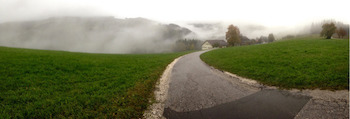
Moselebauer Hotel
Our hosts for the visit were Gernot and Erkki Valikangas the Stora Enso sales manager for Australia. Thank you for your hard work for the day.
Stora Enso factory
Our first visit of the next day was to the Stora Enso factory in Bad St Leonhard. The rain for the day was quite heavy but it didn’t dampen our enthusiasm. Stora Enso is a big company, with some 27,000 employees worldwide and A$15 billion worth of sales. The company is not just about timber and timber products but covers paper, packaging and biomaterials. Check out their website I find the biomaterials development work particularly fascinating.
The company has quite a bit of history, the Swedish copper mining company Stora Kopparberg (“great copper mountain”) in Falun was granted a charter from King Magnus IV of Sweden in 1347, although the first share in the company (granting the Bishop of Västerås 12.5% ownership) dates from 1288. Some claim this to be the oldest existing corporation or limited liability company in the world. You can of course read more on Wikipedia.
The factory at Bad St Leonhard produces a lot of timber, an awful lot of timber, including 70,000m3 of CLT (total CLT capacity of 2 mills is 140,000m3) and some 320,000 tonnes of biomass pellets. It is worth noting that at all the places we have visited and along our travels it is clear that energy from biomass is really common. The industry wastes nothing so anything that is left over is processed and often that is for biomass energy. Driving through villages in Switzerland and Austria it is not uncommon to see small biomass plants supplying a local village.
The CLT production for a single house is 50m3 to 60m3 and is actually where most of the CLT production goes, including over to Finland for creation of modular systems. To quantify the volume produced, the CLT used in the Library at the Docks (Melbourne) was only one day’s production. The library is quite a substantial building so the opportunity for more equivalent buildings certainly exists.
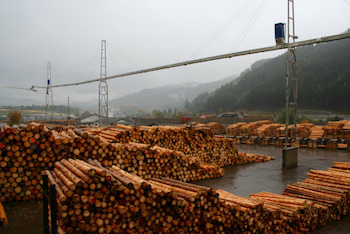
The log yard
Our visit to the log yard and timber mill quantified just how much timber is generated through the plant and the range of products. Even in Australia Stora Enso has 5 warehouses.

Cut timber awaiting processing
The local timber history dates back to 1885 with the start of a small mill.
The CLT plant opened in 2008, and now produces a range of panels, up to 16m x 2.95m x 36cm and either 3, 5 or 7 layers. The products also come in three grades visible, industrial visible and non-visible.
Logs for the mill come from within 100km and are processed down to planks of various dimensions, checked for their quality and dried to the required moisture content. Quality and traceability of all components is key to a good product and this is very clear when walking through the factory.
After the necessary quality checks the longitudinal planks are planed, finger jointed and joined to the required length and the panel glued using polyurethane glue or EPI glue at the edges. This panel is layered with glue and the cross laminate planks added before another longitudinal panel is added. Obviously this is how the 3, 5 or 7 layers are built up. Sorry no photos of this bit – top secret.
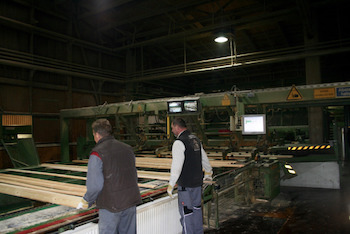
Quality inspection
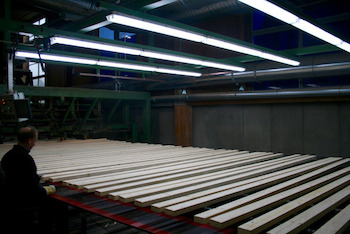
More quality checks
The panels are then cut and planed with the CNC machines to deliver the finished product. The process once again was very logical and of a high quality delivering a constant line of production from the plant.
Of note is that schools are now regular users of CLT, great news as our recent report demonstrated the learning and health benefits of using a timber construction. To add to the sustainability credentials of the CLT it is being tested for use in wind turbine towers.
Kindergarten visit
From the factory we headed out on the bus yet again to visit a Kindergarten being constructed by a local company Doka. Doka is an international producer and supplier of prefabricated formwork used in concrete pouring. The Doka Group has a worldwide workforce of approx. 5,970 with some 2,500 employed locally. I have to apologise to readers that I didn’t take my good camera with me so can only offer a somewhat distorted shot taken with my GoPro.
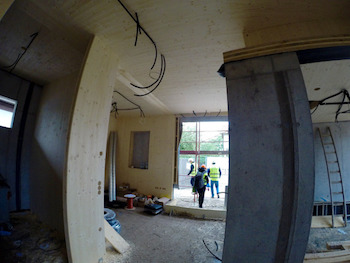
Inside the kindergarten
This was a solid construction a hybrid of concrete and CLT to demonstrate the use of wood and concrete by Doka. This is a small kindergarten for 15 children of employees, the carers and offices above. This is very much a showcase for the company to demonstrate their use of materials. As I said this is a solid building, which is being built with every attention to detail. Insulation, heating, and sound proofing will be of the highest quality. Some of the CLT panels were of a visual grade so care was being taken not to damage them. Also visible was that the panels had been predrilled in the factory to allow threading of cables and insertion of power points. These can be seen in the vertical panel in the centre left of the above picture. A really simple but very effective hybrid construction.
Low cost passive housing
Back on the bus for our final visit, I have to admit by this stage my brain had begun to get full and needed a bit of time to process all I had seen. The weather was getting quite chilly and we were unable to access the buildings. However, the photos show most of the required information. This was a low cost construction for ‘entry level’ housing. Each block contains two homes and is a CLT construction with polystyrene insulation, triple glazed windows and doors and no heating or cooling. These are passive houses, fast to build and designed to have very high thermal efficiency. The pink blocks are designed to house shutters which clearly are hidden away when up but fit snuggly as another layer to prevent heat loss. The area can get down to -20°C so the houses are designed to be efficient with a built in heat recovery system to allow for fresh air to enter in. The doors and windows are substantial like many of the builds we encountered with very solid thick triple glazing. This is a bit experimental for the builders the final product being rendered. The CLT allows a rapid construction time in a matter of weeks followed by the polystyrene insulation and render.
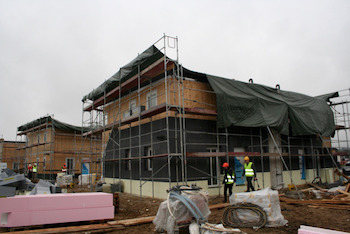
Passive housing
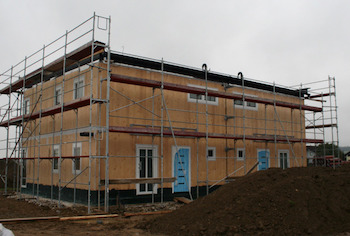
2 house block
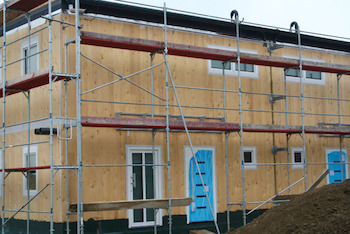
CLT house
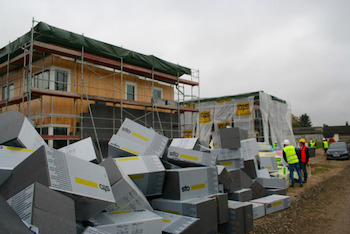
Insulation blocks
A great example of CLT housing and how to build very functional homes rapidly and for a lower cost. It would be great to see similar constructions in Australia.
